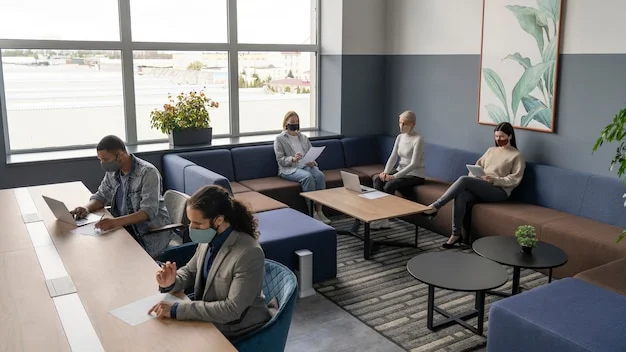Business meetings have evolved as organizations move away from traditional office settings. The shift toward flexible work environments has led to a growing preference for co-working spaces. These shared spaces offer businesses an alternative to conventional boardrooms, providing cost-effective and technology-driven meeting solutions.
The Rise of Coworking Spaces in Business Culture
Coworking spaces have become more than just shared offices. They have transformed into collaboration hubs where businesses, freelancers, and remote teams converge. The rise in remote work and hybrid models has accelerated the demand for flexible meeting environments. Companies that no longer maintain large office spaces seek professional settings to host discussions, and co-working spaces provide an ideal solution.
The increasing adoption of co-working spaces is driven by convenience. Organizations can book meeting rooms as needed, eliminating the burden of maintaining permanent office spaces. Startups and small businesses, in particular, benefit from this model, as it allows them to access premium meeting facilities without long-term commitments.
Flexible and Cost-Effective Meeting Solutions
Traditional office spaces require businesses to invest in infrastructure, utilities, and maintenance. Co-working spaces remove these overhead costs by offering meeting rooms on demand. Businesses can choose from a range of room sizes and layouts, ensuring they pay only for what they need.
The flexibility of coworking conference rooms allows businesses to scale their requirements based on their needs. Whether it is a one-on-one discussion, a brainstorming session, or a large client presentation, co-working spaces offer solutions that fit different meeting formats. This model appeals to companies that operate remotely but still require professional spaces for important discussions.
Enhanced Collaboration Through a Shared Environment
Traditional offices often limit interaction to in-house teams, while co-working spaces encourage networking. The shared environment fosters interactions between professionals from different industries, leading to knowledge exchange and potential partnerships. Meetings held in such spaces often result in unexpected collaborations, providing opportunities beyond the agenda of a scheduled discussion.
Co-working spaces promote an open and engaging atmosphere, making business meetings less rigid. Informal discussions over coffee in shared lounges can be just as productive as structured meetings in boardrooms. The presence of diverse professionals within the same space encourages creativity and fresh perspectives.
Technology-Driven Meeting Experiences
Co-working spaces are designed to meet the technological needs of modern businesses. Meeting rooms are equipped with high-speed internet, video conferencing tools, and smart displays, ensuring seamless virtual collaboration. Remote attendees can participate without facing connectivity issues, bridging the gap between in-person and virtual interactions.
Many co-working providers integrate cloud-based booking systems that allow businesses to reserve rooms effortlessly. These platforms eliminate scheduling conflicts and provide transparency in availability. Some spaces even offer automated check-ins and access control, improving security while maintaining convenience.
A Shift Toward More Engaging Meeting Formats
The rigid format of traditional meetings is being replaced by more engaging styles. Co-working spaces support interactive workshops, brainstorming sessions, and panel discussions, allowing teams to move away from one-directional presentations. The availability of modular furniture, writable walls, and breakout zones encourages dynamic participation.
Meetings held in such spaces often involve a mix of structured discussions and informal networking. The change in setting from a conventional boardroom to a creative environment helps participants remain engaged, leading to more effective decision-making.
Accessibility and Location Advantage
Businesses no longer need to confine meetings to a central office. Co-working spaces are strategically located in business districts, making them easily accessible to clients and employees. The option to book rooms in multiple locations allows businesses to hold meetings in areas that are convenient for all participants.
This geographical flexibility benefits businesses that operate in multiple cities or those that frequently meet with external stakeholders. Instead of requiring participants to travel long distances, meetings can be scheduled in locations that minimize inconvenience.
Addressing Privacy and Security Concerns
While co-working spaces offer numerous benefits, privacy remains a concern for businesses handling sensitive discussions. Providers have addressed this by offering soundproof meeting rooms and controlled access areas. Businesses can book exclusive spaces to ensure confidentiality during critical discussions.
Security measures such as encrypted Wi-Fi, visitor check-ins, and surveillance systems provide additional assurance. Companies conducting high-stakes negotiations or handling proprietary information can select co-working providers that prioritize data security.
The Future of Business Meetings in Shared Spaces
The demand for co-working meeting spaces is expected to grow as businesses continue to embrace flexible work models. Future developments will focus on enhancing user experiences through smart technology, sustainable design, and integrated digital tools. The blend of physical and virtual meeting spaces will further refine how businesses conduct discussions.
Companies will continue to seek environments that promote collaboration, creativity, and convenience. Co-working spaces have positioned themselves as an essential part of this shift, redefining how businesses approach meetings. The combination of flexibility, technology, and accessibility ensures that co-working spaces will remain a preferred choice for organizations looking to optimize their meeting strategies.







